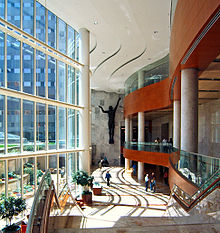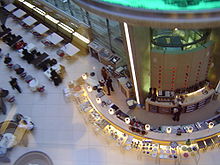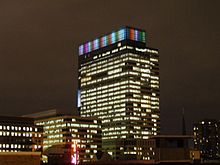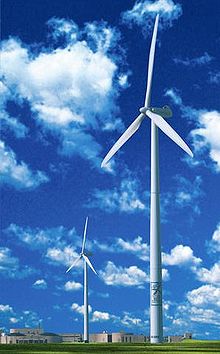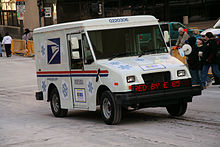- Economy of Minnesota
-
Economy of Minnesota 
state quarterOutput Gross state product $275,676 million[1] Income per capita $42,843[2] Labor force Labor force size 3,009,800 [3] Unemployment rate 7.2%[4] Inequality and poverty Gini index 0.439[5] Poverty rate 9.6%[6] Public sector Budget expenditures $17,555 million[7] Tax revenue $17,208.877 million[8]
The economy of Minnesota produced US$ of gross domestic product in 2005.[9] Minnesota headquartered 31 publicly traded companies in the top 1,000 U.S. companies by revenue in 2011.[10] This includes such large companies as Target, and UnitedHealth Group. The per capita personal income in 2004 was $36,184, ranking eighth in the nation.[11] The median household income in 2005 was approximately $52,024, ranking eleventh in the nation.[12]Contents
Income and retail
Average household incomes range from $17,369 in Todd County to $42,313 in Hennepin County. Salaries are highest in the urban and suburban counties of the twin cities metropolitan area. Retail sales per capita were $10,260 in 1997, higher than the U.S. average of $9,190. The Twin Cities suburb of Roseville has the highest per capita sales, which recorded $14,870 per capita, but total revenues are much higher in Minneapolis, St. Paul, Bloomington, and Edina.
Industry and commerce
 Corn field
Corn field
Minnesota's economy has transformed in the past 200 years from one based on raw materials to one based on finished products and services.
The earliest industries were fur trading and agriculture. Agriculture is still a major part of the economy even though only a small percentage of the population, less than 1% are employed in the farming industry.[13]
Minnesota is the U.S.'s largest producer of sugar beets, sweet corn, and green peas for processing and farm-raised turkeys.[14] State agribusiness has changed from production to processing and the manufacturing of value-added food products by companies such as General Mills, Cargill, Hormel Foods Corporation (prepackaged and processed meat products), and the Schwan Food Company (frozen foods).
 Red pine forest
Red pine forest
Forestry, another early industry, remains strong with logging, pulpwood processing, forest products manufacturing, and paper production. The amount of forested land in the state is declining, from 16.7 million acres (68,000 km²) in 1990 to 16,200,000 acres (66,000 km2) in 2004; however, the average forest is maturing. From 1999 to 2004 the average annual growth within the state was 550 million board-feet (1,300,000 m³) of timber, while the average amount harvested was only 330 million board-feet (780,000 m³) per year.[15]
Minnesota was famous for its soft-ore iron mines which produced a significant portion of the world's iron ore for over a century. Although the pure ore is now depleted, taconite mining remains strong using processes developed locally to save the industry. In 2004 the state produced 75 percent of the usable iron ore in the country.[14] 3M (formerly Minnesota Mining and Manufacturing Co.) today is a diversified manufacturer of industrial and consumer products. The port of Duluth was created by the mining boom and today continues to be an important shipping port for the Midwest's agricultural and ore products.
Manufacturing was not left out, either. The brass era automobile maker Dan Patch was founded in Minneapolis in 1911.[16]
Retail is represented by Target Corporation, Best Buy, and Supervalu, all headquartered in the Twin Cities. Southdale Center, the first fully enclosed and completely climate-controlled shopping mall in the United States opened on October 8, 1956, in the suburban city of Edina. The largest shopping mall in the United States, the Mall of America, is located in Bloomington.
Medtronic and St. Jude Medical represent a growing biomedical industry spawned by university research, and Rochester is the headquarters of the world-famous Mayo Clinic. UnitedHealth Group is the second largest health insurance company in the U.S.
Financial institutions include U.S. Bancorp, TCF Bank, Ameriprise and Thrivent Financial for Lutherans.
As might be expected in state with a love of the outdoors, boats and other recreational products are manufactured by a number of Minnesota companies, including Polaris Industries and Arctic Cat, who make snowmobiles and ATVs, Alumacraft Boat Company, and Lund Boats.
An active high-technology sector is represented by Alliant Techsystems, Cray, Imation, and a large IBM plant in Rochester.
Today, the most salient characteristic of the economy is its diversity; the relative outputs of its business sectors closely match the United States as a whole.[17]
Minnesota's largest companies
Nonprofits
The following table lists the Minnesota-based non-profit organizations among the largest 400 in the U.S. by 2006 private donations.[18]
State Rank
by RevenueName National
RankDonations ($millions)
2006 estimateHeadquarters City 1 Mayo Clinic 45 265.9 Rochester 2 University of Minnesota 46 265.4 Minneapolis 3 Scholarship America 114 136.2 St. Peter 4 Minnesota Public Radio 378 40.3 St. Paul 5 Hope for the City 379 40.3 Edina Private companies
The following table lists the privately held companies headquartered in Minnesota with 2007 revenues over $1 billion.[19]
State Rank
by RevenueCompany Name National
RankRevenue
($billions) 2007 estimateEmployees Headquarters City Known for 1 Cargill 1 107.90 131,000 Minnetonka Farm Products 2 Carlson 87 38.00 170,000 Minnetonka Travel and Lodging 3 Schwan Food Company 124 3.30 17,000 Marshall Dairy Products and Frozen Foods 4 Andersen Corporation 136 3.00 10,600 Bayport Windows and Building Materials 5 Rosen's Diversified 184 2.40 4,200 Fairmont Meat Products 6 M A Mortenson 218 2.14 2,700 Robbinsdale Heavy Construction 7 Fagen 227 2.08 3,600 Granite Falls Heavy Construction 8 Holiday Cos. 238 2.00 4,600 Bloomington Retailing 9 Taylor Corp. 286 1.70 12,500 North Mankato Publishing – Periodicals 10 Ceridian 295 1.65 9,500 Bloomington Information Technology Services 11 Buffets, Inc. 334 1.46 38,000 Eagan Restaurants 12 API Group 351 1.35 6,000 New Brighton Conglomerates 13 Lifetouch 424 1.05 20,000 Eden Prairie Photography 14 Ryan Companies 427 1.04 600 Minneapolis Heavy Construction Public companies
The following table lists the public companies headquartered in Minnesota with 2010 revenues placing them in the 1000 largest U.S. companies.[10]
State Rank
by RevenueCompany Name National
RankRevenue ($millions)
2010 estimateHeadquarters City Known for 1 UnitedHealth Group 22 94,155 Minnetonka Managed Health Care 2 Target 33 67,390 Minneapolis Retailing 3 Best Buy 47 49,694 Richfield Retailing 4 Supervalu 61 40,597 Eden Prairie Food Distribution and Retailing 5 3M 97 26,692 Maplewood Diversified Manufacturing 6 CHS, Inc. 103 25,268 Inver Grove Heights Fuel Distribution 7 US Bancorp 126 20,518 Minneapolis Banking and Finance 8 Medtronic 158 15,817 Fridley Medical Devices 9 General Mills 166 14,796 Golden Valley Food Processing 10 Land O' Lakes 218 11,146 Arden Hills Dairy Products 11 Xcel Energy 237 10,311 Minneapolis Electricity Production and Distribution 12 Ameriprise 246 10,046 Minneapolis Financial Planning 13 C.H. Robinson Worldwide 265 9,274 Eden Prairie Logistic Services 14 Thrivent Financial for Lutherans 318 7,471 Minneapolis Financial Products 15 Hormel Foods 325 7,221 Austin Meat Processing 16 Mosaic 346 6,759 Plymouth Fertilizer Manufacturing 17 Ecolab 378 6,090 St. Paul Sanitation Supplier 18 St. Jude Medical 436 5,165 Little Canada Medical Devices 19 Nash Finch 449 4,992 Edina Food Distribution 20 Alliant Techsystems 472 4,808 Eden Prairie Defense Contractor 21 Valspar 618 3,482 Minneapolis Paint and Coatings 22 Pentair 627 3,395 Golden Valley Water Treatment 23 Patterson 687 2,999 Eagan Dental and Veterinarian Supplies 24 Securian/Minnesota Life 729 2,746 St. Paul Life Insurance 25 Regis 730 2,739 Edina Hair Salons 26 Fastenal 813 2,340 Winona Fastener Manufacturer 27 Donaldson 836 2,233 Bloomington Filtration Products 28 Imation 860 2,155 Oakdale Data Storage Products 29 Polaris Industries 911 1,948 Medina Snowmobiles and ATVs 30 Toro 936 1,878 Bloomington Lawn and Irrigation Equipment 31 Michael Foods 961 1,804 Minnetonka Packaged Foods Energy use and production
See also: Common ethanol fuel mixturesThe state does not produce any petroleum of its own but boasts the largest oil refinery of any non-oil-producing state, the Pine Bend Refinery. As of 2001, Minnesotans were using a total of 7.2 million US gallons (27,000 m3) of gasoline per day, and fuel use rises in the region by about 2% annually. About 70% of the gasoline fuel used in the state comes from Pine Bend and the nearby St. Paul Park Refinery, while most of the rest comes from a combination of the Mandan Refinery in North Dakota, and the Superior Refinery in Superior, Wisconsin. 40 to 50% of Pine Bend's output is used within the state. Flint Hills is currently planning a $100 million expansion to increase capacity at the plant to about 330,000 barrels per day (52,000 m3/d). Petroleum from the north comes to the state through one of the longest pipelines in the world, the Lakehead Pipeline and the Minnesota Pipeline. Additional crude comes from the south via the Wood River Pipeline.
Ethanol fuel is produced in the state, and consumer gasoline is required to contain 10% ethanol (E10). As of 2006, Minnesota is the only U.S. state with such a mandate. 20% ethanol (E20) will be mandated in 2013.[20] Minnesota has the highest number of fuel stations offering E85 fuel, with 300 statewide.[21] A 2% biodiesel blend has also been required in diesel fuel since 2005. Electricity-producing wind turbines have become popular, particularly in the windy southwest region on the Buffalo Ridge. As of November 2006, the state is the country's fourth-largest producer of wind power, with 812 megawatts installed and another 82 megawatts planned.[22]
Like other Midwestern states that experience cold winters, Minnesota is heavily dependent on natural gas for home heating. Just over two-thirds of homes use the fuel.
State taxes
Minnesota's income tax is slightly progressive with three rates, 5.35%, 7.05% and 7.85%.[23] The sales tax in Minnesota for most items is 6.875% effective July 1, 2009.[24] The state does not charge sales tax on clothing, some services, or food items for home consumption.[25] The state legislature may allow municipalities to institute local sales taxes and special local taxes, such as the 0.5% supplemental sales tax in Minneapolis.[26] The cities of St. Paul, Rochester, Duluth and St. Cloud have similar taxes. Excise taxes are levied on alcohol, tobacco, and motor fuel. The state imposes a use tax on items purchased elsewhere but used within Minnesota. Owners of real property in Minnesota pay property tax to their county, municipality, school district, and special taxing districts. The overall state and local tax burden is calculated to average 11.9% in 2006, ranking 4th highest in the country.[27]
Gaming
Minnesota residents and visitors can legally gamble on the lottery, for instance; its games include Powerball, Hot Lotto, both multi-state games, Gopher 5, Northstar Cash, and numerous scratch tickets.
References
- ^ http://research.stlouisfed.org/fred2/graph/?id=MNNGSP
- ^ http://research.stlouisfed.org/fred2/graph/?id=MNPCPI
- ^ http://research.stlouisfed.org/fred2/data/MNLFN.txt
- ^ http://research.stlouisfed.org/fred2/data/MNUR.txt
- ^ http://factfinder.census.gov/servlet/DTTable?_bm=y&-context=dt&-ds_name=ACS_2009_1YR_G00_&-_geoSkip=0&-CONTEXT=dt&-mt_name=ACS_2009_1YR_G2000_B19083&-tree_id=307&-_skip=0&-redoLog=false&-geo_id=04000US01&-geo_id=04000US02&-geo_id=04000US04&-geo_id=04000US05&-geo_id=04000US06&-geo_id=04000US08&-geo_id=04000US09&-geo_id=04000US10&-geo_id=04000US11&-geo_id=04000US12&-geo_id=04000US13&-geo_id=04000US15&-geo_id=04000US16&-geo_id=04000US17&-geo_id=04000US18&-geo_id=04000US19&-geo_id=04000US20&-geo_id=04000US21&-geo_id=04000US22&-geo_id=04000US23&-geo_id=04000US24&-geo_id=04000US25&-geo_id=04000US26&-geo_id=04000US27&-geo_id=04000US28&-geo_id=04000US29&-geo_id=04000US30&-geo_id=04000US31&-geo_id=04000US32&-geo_id=04000US33&-geo_id=04000US34&-geo_id=04000US35&-geo_id=04000US36&-geo_id=04000US37&-geo_id=04000US38&-geo_id=04000US39&-geo_id=04000US40&-geo_id=04000US41&-geo_id=04000US42&-geo_id=04000US44&-geo_id=04000US45&-geo_id=04000US46&-geo_id=04000US47&-geo_id=04000US48&-geo_id=04000US49&-geo_id=04000US50&-geo_id=04000US51&-geo_id=04000US53&-geo_id=04000US54&-geo_id=04000US55&-geo_id=04000US56&-geo_id=04000US72&-search_results=01000US&4-_showChild=Y&-format=&-_lang=en&-_toggle=
- ^ http://www.census.gov/compendia/statab/2011/ranks/rank34.html
- ^ http://nasbo.org/LinkClick.aspx?fileticket=w7RqO74llEw%3d&tabid=79
- ^ http://www.census.gov/govs/statetax/1024mnstax.html
- ^ "News Release: Gross Domestic Product (GDP) by State, 2005". U.S. Department of Commerce. 2006. http://www.bea.gov/bea/newsrel/GSPNewsRelease.htm. Retrieved 2006-12-12.
- ^ a b "Fortune 500 2007". Our annual ranking of America's largest corporations (CNNMoney.com; Cable News Network LP, LLLP. A Time Warner Company). 2007. http://money.cnn.com/magazines/fortune/fortune500/2007/states/MN.html. Retrieved 2007-05-11.
- ^ "Bureau of Economic Analysis: Regional Economic Accounts". U.S. Department of Commerce. http://www.bea.gov/bea/regional/bearfacts/stateaction.cfm?fips=27000&yearin=2004. Retrieved 2006-06-22.[dead link]
- ^ "DP-3. Profile of Selected Economic Characteristics: 2000". U.S. Census Bureau. http://factfinder.census.gov/servlet/GRTTable?_bm=y&-_box_head_nbr=R2001&-ds_name=ACS_2005_EST_G00_&-format=US-30. Retrieved 2006-12-12.
- ^ "DP-3. Profile of Selected Economic Characteristics: 2000". U.S. Census Bureau. http://factfinder.census.gov/servlet/QTTable?_bm=y&-geo_id=04000US27&-qr_name=DEC_2000_SF3_U_DP3&-ds_name=DEC_2000_SF3_U&-_lang=en&-_sse=on. Retrieved 2006-12-12.
- ^ a b "Wealth of Resources". Positively Minnesota. Minnesota Department of Employment and Economic Development. 2006. http://www.deed.state.mn.us/whymn/resources.htm. Retrieved 2006-12-13.
- ^ "Minnesota's Forest Resources 2004". U.S. Dept. of Agriculture. http://www.ncrs.fs.fed.us/pubs/rb/rb_nc262.pdf. Retrieved 2006-12-12.[
- ^ Named for the horse. Clymer, Floyd. Treasury of Early American Automobiles, 1877–1925 (New York: Bonanza Books, 1950), p.158.
- ^ "Environmental Information Report, App. D Socioeconomic Information" (PDF). 2003-05-30. http://www.pca.state.mn.us/publications/reports/eir-appendix-e.pdf. Retrieved 2006-11-19.
- ^ "Philanthropy 400: Minnesota". The Chronicle of Philanthropy. 2006. Archived from the original on 2007-09-27. http://web.archive.org/web/20070927220240/http://www.philanthropy.com/premium/stats/philanthropy400/2006/2006phl400results.php. Retrieved 2007-05-20.
- ^ Reifman, Shlomo and Murphy, Andrea D (eds.) (2008-11-03). "America's Largest Private Companies". Forbes. http://www.forbes.com/2008/11/03/largest-private-companies-biz-privates08-cx_sr_1103private_land.html. Retrieved 2009-10-27.
- ^ "2005 Senate Bill 4 (Ethanol Mandate Increase)". Minnesota Votes. http://www.minnesotavotes.org/2005-SF-4. Retrieved 2006-11-26.
- ^ "Consumer Info and Services". Minnesota Department of Commerce. Archived from Minnesota Commerce : E85 Fuel Station List the original on 2006-10-12. http://web.archive.org/web/20061012231938/http://www.state.mn.us/portal/mn/jsp/content.do?subchannel=-536881511&programid=536907776&sc3=null&sc2=-536888997&id=-536881350&agency=Commerce. Retrieved 2006-10-19.
- ^ "Wind Energy Projects Throughout the United States of America". The American Wind Energy Association. http://www.awea.org/projects. Retrieved 2006-11-26.
- ^ "Minnesota income tax rates for 2005/2006". Minnesota Department of Revenue. http://www.taxes.state.mn.us/individ/residency_and_filing_status/filing_requirments_for_individuals/inctxrates.shtml. Retrieved 2006-11-26.
- ^ "General sales and use tax rate increases to 6.875% beginning July 1, 2009". Minnesota Department of Revenue. http://www.taxes.state.mn.us/taxes/sales/tax_information/content/general_rate_increase.shtml. Retrieved 2009-09-09.
- ^ "Sales tax fact sheets". Minnesota Department of Revenue. http://taxes.state.mn.us/taxes/sales/publications/fact_sheets_by_name/sales_fact_sheet_by_name.shtml. Retrieved 2006-11-26.
- ^ "Local Sales Tax and Use" (PDF). Archived from the original on 2006-10-09. http://web.archive.org/web/20061009052806/http://www.taxes.state.mn.us/taxes/sales/publications/fact_sheets_by_name/content/BAT_1100111.pdf. Retrieved 2006-11-26.
- ^ "Minnesota State-Local Tax Burden Compared to U.S. Average (1970–2006)". Tax Foundation. 2006. http://www.taxfoundation.org/files/minn.pdf.
External links
Business
- Start a Business in Minnesota
- Small Business Community of Minnesota
- Small business Administration of Minnesota
- Minnesota Office of the Secretary of State forms and documents
Categories:
Wikimedia Foundation. 2010.



